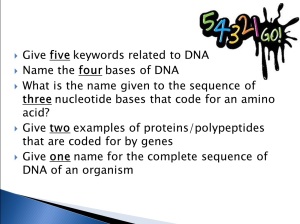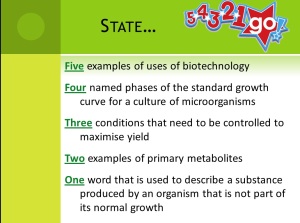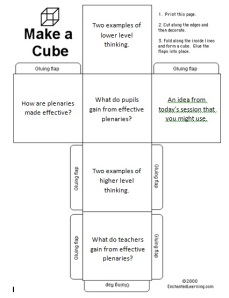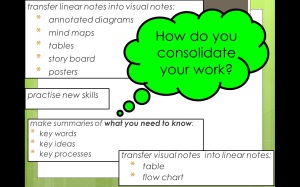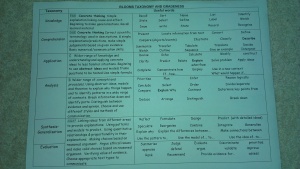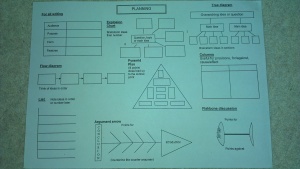We are all familiar with the student who never speaks up in class. They are painfully quiet. They are the student whose name we learn last at the start of the academic year, but perhaps they will turn out to be the one student we worry about the most.
It would be wrong to call our quiet students introverts. Yes some genuinely are introverted (as I was at school – how I ever became a teacher is anyone’s guess) but others are more a ‘think before I speak kind of student’. On occasions, where we are short of time to fit in that plenary, the ‘think before I speak’ students just don’t receive ‘thinking’ time they need, so as a result they don’t speak.
Of course there’s a second category of students who may be remaining quiet; those who have not engaged with the lesson or task and actually could not contribute to the class discussion. There could be any number of reasons for their non-engagement. Perhaps they genuinely didn’t ‘get it’. Perhaps they are an EAL student so language has been an issue. Perhaps they left home too late to eat breakfast and all they can think about is break time. Perhaps they’ve just spilt up with their girlfriend. There are many more ‘perhaps’ suggestions I could add.
I should point out that I am aiming to tackle the first category of quiet students, rather than the more complicated second category. The second category will require a much more individualised approach and could form several different blog posts in themselves.
Strategies to engage the quiet students
1. Start at the classroom door. Forgive me for stating the obvious but it is so easy to let students bustle into your classroom, while you are searching for their books, displaying your PowerPoint presentation, etc. Be organised. Have everything ready so you can greet all students at the door to make them feel welcome.
2. Use their name regularly. Students feel more valued in their participation if they feel ‘known’ to the class and to the teacher…. Of course they also realise they cannot hide from you.
3. Foster a safe learning environment. Students need to feel both secure and respected in your classroom. If the classroom is more collaborative and exploratory then the positive reinforcement gained from this will hopefully allow quiet students to open up. I shudder at the thought of a student feeling so uneasy in my classroom that they’d rather not be there – akin to a goldfish trying to escape a crowded bowl.

4. Spend time with your quiet students. While circulating your classroom, the noisier students are more likely to command your attention. Make an effort to chat with the quiet ones about their work. Build a rapport with them so they are comfortable sharing ideas with you.
5. Remember to praise regularly. It is so easy to reward the extroverts and miss the quiet students. Praise features like confidence, cooperation and consideration, as well as the academic ones.
6. Think about group work carefully. It may seem like a great idea to place the hard working quiet student with the loud ‘hands up for everything’ student. While both student types are what makes a classroom a great place to be, asking them to work together could be a recipe for disaster. I expect the loud student dominates the conversation, and the thoughts of the quiet one are not heard. Two possible ways around this are to group students with similar personalities (although this brings its own perils!) or to give each student a role to perform in the group. In fact, this is not an either or situation. I believe that to make any form of group work successful, students need a role. Assigning roles that suit students’ personalities (researcher, reporter, TV show host, design consultant, and so on) will allow the quiet students to feel comfortable in their group.
6. Give students time to think about and rehearse their answers. For example, pose a question, give discussion time with a partner or time to write an answer, then ask for feedback. This could take the form of the common ‘think, pair, share’ approach to questioning. Yes this takes more time than a snappy short answer question session, but if the questions are carefully thought out it can be far more valuable in assessing deep learning.
7. Give students a way to express themselves in a sheltered way. A way that lies within their comfort zone. In my experience, quiet students are usually comfortable demonstrate their knowledge by writing it down. Get them to summarise their ideas by writing it on a mini-whiteboard (with the advantage of being able to amend this too), as a Facebook status, a tweet, a text, a blog post, or on a post-it note.
8. Take away the element of teacher choice when selecting pupils to contribute. So if we must ask the quiet ones to speak, not only will rehearsal time help, but also reducing the idea of being ‘picked on’. No teacher aims to ‘pick on’ students, but if you are a quiet student, that is probably exactly how it feels.
Here are some ideas:
a) Have a set of lolly sticks per class. Each lolly stick has one student’s name written on it. Select these at random. Or even get another student to select.
b) Use the Random Name Picker on classtools.net. You need to set it up by adding names in advance but then a simple click leads to a random student being selected.
c) A cuddly toy, inflatable globe, (soft!) football or something similar. You will need to start the process by passing the ball to a student. They answer the first question and pass the ball (the only time I allow throwing in my classroom!) to a student of their choice who answers the next question, and so on. Yes for some students, receiving the ball is their idea of a nightmare but for others it is almost as if the ball gives them permission to speak.
9. Take away the element of students volunteering their answers. To do this, try a no hands up approach to a class discussion. In my opinion, a teacher needs to know their class well enough to establish if this will be a successful approach. After all, it may result in exactly what we are trying to avoid; the confident students dominating the conversation and the quiet students staying quiet. However, if organised well, it can be successful.

10. Ask students to assess their own participation. Many students are keen to do their teacher proud. Many students will want to improve if there is a blindingly obvious area in which they can do so. Give them the chance by encouraging them to assess their participation and set themselves a target to assist them in that improvement.
After all I have mentioned here, a key point to remember is that it is unlikely that these quiet students will change. Indeed we should not try to change them. Having been one of them at school, I cannot tell you how demoralising it is for every subject report to say ‘must speak out in class more frequently’. From a teacher point of view, I can see why my teachers were saying that. I was making it incredibly hard for them to judge my progress quickly. Rather our intentions should be more to allow quiet students to realise that we are merely trying to understand how to support their needs. And for that I hope that some students at least will be grateful.
Please comment below if you have any thoughts on how to further encourage involvement of our quiet students.
 This is a really simple idea but I find it effective in lessons at any key stage and with any topic. The idea is that the teacher tailors questions within a certain topic so that the answers will require ‘5….’ ‘4….’ ‘3….’ and so on.
This is a really simple idea but I find it effective in lessons at any key stage and with any topic. The idea is that the teacher tailors questions within a certain topic so that the answers will require ‘5….’ ‘4….’ ‘3….’ and so on.